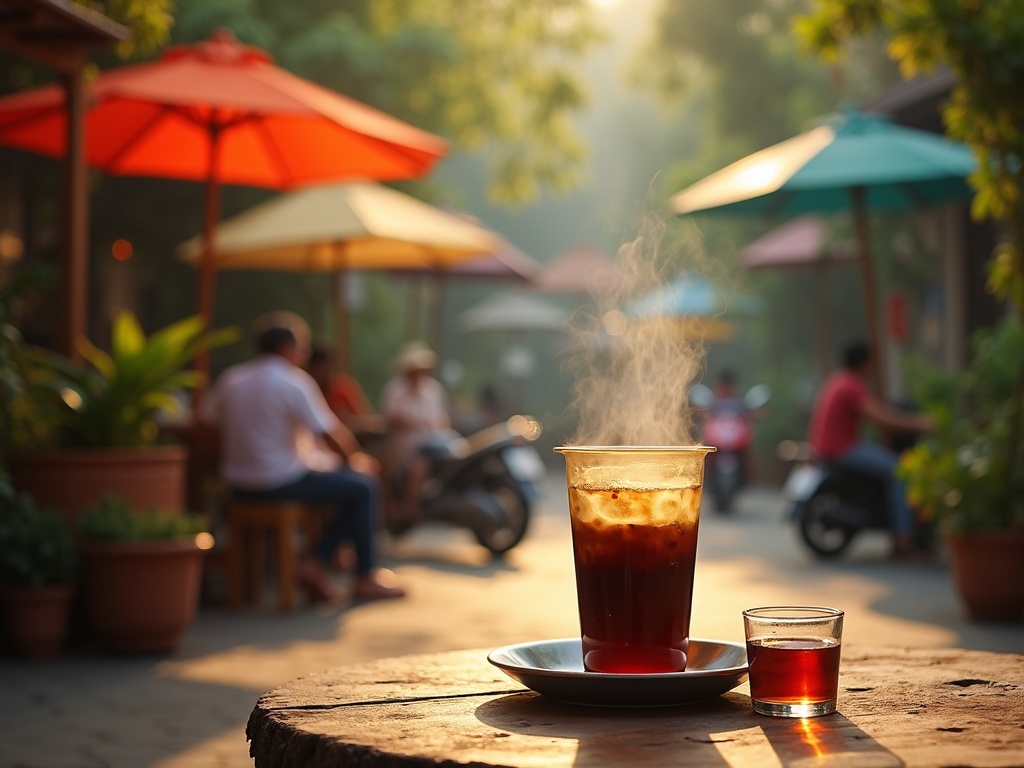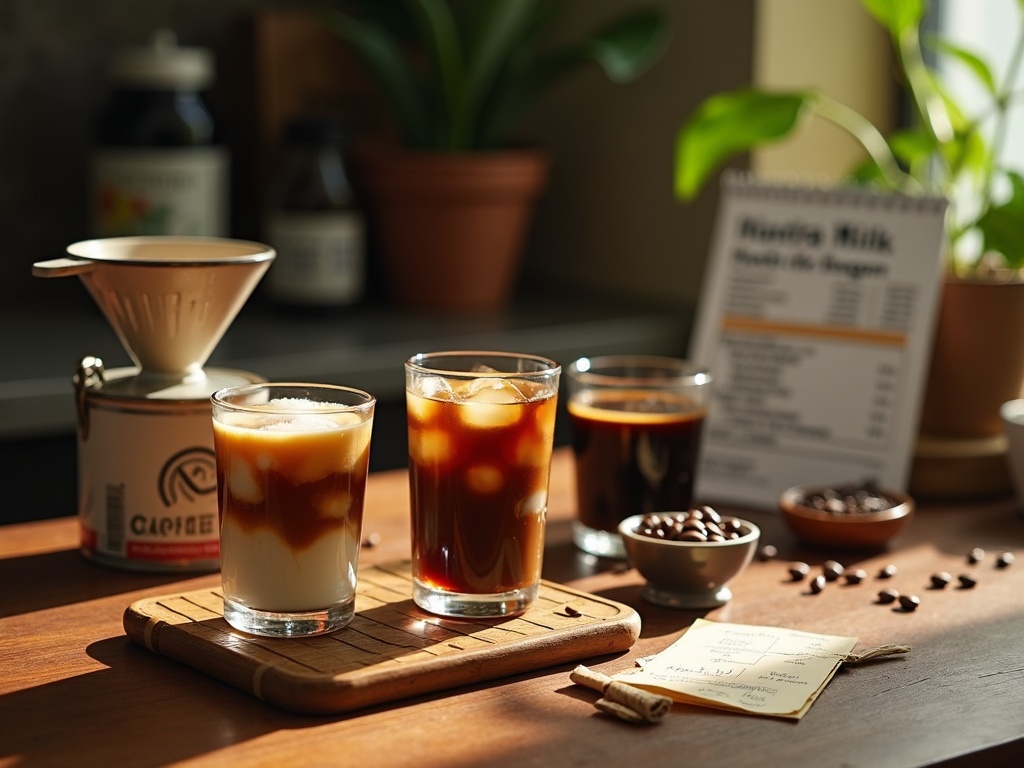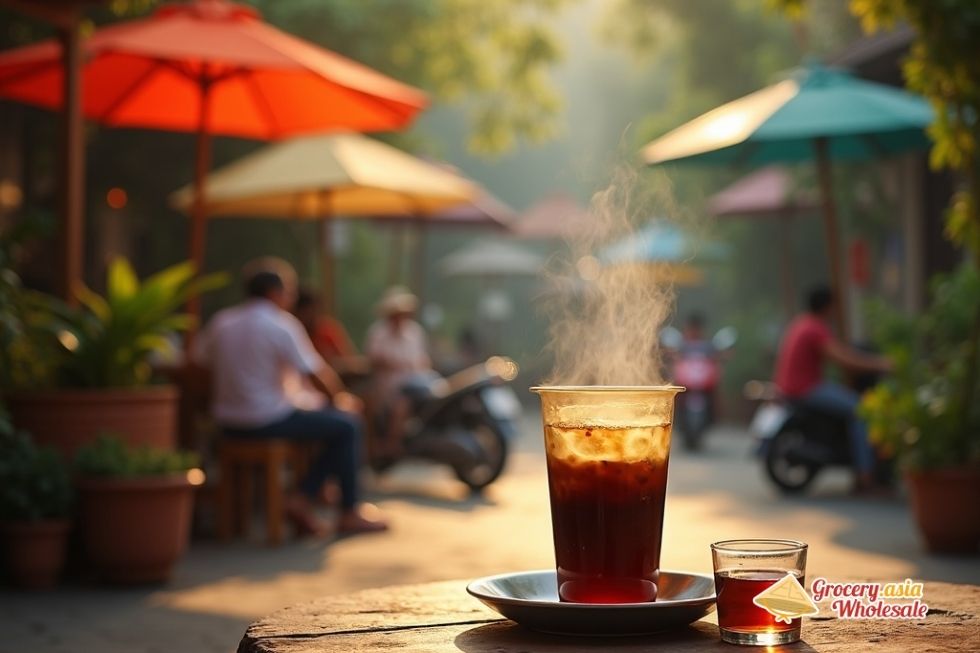No products in the cart.
Beverages News, Coffee
Is Vietnam Coffee Good For Daily Drinking
Vietnamese coffee stands out in the global coffee landscape with its distinctive Robusta bean foundation. These beans deliver nearly double the caffeine content of typical Arabica varieties and pack substantial antioxidant benefits through elevated Chlorogenic Acid concentrations. Traditional preparation methods incorporate sweetened condensed milk, creating a cultural drinking ritual. Health-conscious consumers can modify brewing techniques to reduce sugar content while preserving the coffee’s signature intensity and flavor characteristics.
Table of Contents
Key Takeaways
- Vietnamese coffee delivers 150–250mg of caffeine per cup compared to 90–120mg in regular coffee, making it ideal for those wanting sustained energy—but requiring careful consideration for caffeine-sensitive individuals.
- Robusta beans supply superior antioxidant content with 7–10% Chlorogenic Acid concentration. These compounds provide anti-inflammatory properties and aid in blood sugar regulation when consumed black or with minimal sweeteners.
- Traditional preparation using sweetened condensed milk adds about 130 calories and 22 grams of sugar per serving, potentially nearing the daily recommended sugar limits for many adults.
- Popular and accessible Vietnamese coffee brands like Trung Nguyên Legend, G7 Instant Coffee, and Nguyen Coffee Supply make authentic Vietnamese coffee budget-friendly and convenient for daily enjoyment.
- Vietnamese coffee best suits power drinkers seeking bold flavor and high energy. Health-conscious individuals can still enjoy it by drinking it black and monitoring caffeine intake to stay within the 400mg daily limit.
The Bold World of Vietnamese Robusta: A Flavor Powerhouse
Vietnamese coffee stands apart from typical Western café offerings through its distinctive use of Robusta beans (Coffea canephora). I find this choice creates a completely different coffee experience compared to the Arabica varieties you’ll encounter in most specialty coffee shops. Vietnam’s coffee quality stems largely from this bold bean selection and the unique growing conditions.
Robusta’s Distinctive Character Profile
Robusta beans deliver a bold, earthy flavor foundation with prominent nutty and chocolatey notes. The finish carries a characteristic bitterness that pairs perfectly with the traditional sweetened condensed milk preparation. Low acidity levels make this coffee gentle on sensitive stomachs while maintaining a full-bodied intensity that satisfies serious coffee drinkers.
Vietnam dominates global Robusta production, contributing over 95% of the country’s total coffee output. The Central Highlands region, particularly around Buôn Ma Thuột, serves as the epicenter of this massive industry. These high-altitude growing conditions and volcanic soil create ideal circumstances for developing Robusta’s signature flavor compounds.
Comparing Coffee Personalities
I often describe the difference between Vietnamese Robusta and typical Arabica using an alcohol analogy. Robusta resembles a dark stout beer – intense, full-bodied, and commanding attention with every sip. Arabica, conversely, mirrors a lighter, aromatic wine with delicate floral notes and bright acidity.
This comparison helps explain why Vietnamese coffee’s strength appeals to different palates than Western coffee preferences. Daily coffee drinkers who find acidic coffees too sharp or sour gravitate toward Robusta’s smoother, less acidic profile. The fuller flavor stands up beautifully to milk and sweeteners without losing its character.
Robusta’s natural caffeine content runs nearly double that of Arabica beans, contributing to both the intensity and the energizing effect that makes Vietnamese coffee so satisfying. This higher caffeine level also acts as a natural preservative and pest deterrent during growing, explaining why Vietnamese farmers have successfully cultivated these beans for generations.
The earthy, chocolatey notes in Vietnamese Robusta complement the traditional Vietnamese coffee culture perfectly. These flavors marry seamlessly with condensed milk, creating the beloved cà phê sữa đá that has become synonymous with Vietnamese coffee worldwide.

Double the Buzz: Understanding Vietnamese Coffee’s Caffeine Content
Vietnamese coffee packs a significantly stronger caffeine punch than your typical morning brew. Vietnamese coffee’s strength stems from its heavy reliance on Robusta beans, which contain nearly double the caffeine of Arabica varieties. While Arabica beans average around 1.5% caffeine by weight, Robusta delivers approximately 2.5%, creating that intense wake-up call Vietnam’s coffee is famous for.
A single cup of traditional Vietnamese coffee typically contains between 150-250 mg of caffeine, compared to the 90-120 mg found in regular coffee. This means you’re getting almost twice the stimulation in each serving. The FDA sets the safe daily caffeine limit at 400 mg for healthy adults, which means just two cups of Vietnamese coffee can bring you close to this threshold.
Managing Your Caffeine Intake
For those sensitive to caffeine, Vietnamese coffee’s intensity can trigger unwanted side effects. High caffeine levels may cause jitters, anxiety, rapid heartbeat, or sleep disruption, particularly if consumed later in the day. I recommend starting with one cup and carefully monitoring your body’s response before increasing consumption.
Daily Vietnamese coffee drinkers should consider these practical strategies:
- Begin with half portions to assess your tolerance
- Avoid drinking Vietnamese coffee after 2 PM to prevent sleep interference
- Alternate with lower-caffeine options throughout the week
- Stay hydrated, as caffeine can have mild diuretic effects
- Consider instant varieties for better portion control
Vietnamese instant options like G7 offer an excellent solution for managing caffeine intake while preserving authentic flavor. These products allow you to control both portion size and intensity, making it easier to enjoy Vietnamese coffee culture without overwhelming your system. You can start with smaller amounts and gradually increase as your tolerance builds.
The high caffeine content isn’t necessarily a drawback – many coffee enthusiasts specifically seek out Vietnamese coffee for its energizing properties. Understanding these levels helps you make informed choices about when and how much to consume, ensuring you can appreciate this distinctive brewing tradition without experiencing negative effects.

The Sweet Dilemma: Traditional Preparation and Health Impacts
Understanding the Sugar Content in Vietnamese Coffee
I can’t discuss Vietnamese coffee quality without addressing the elephant in the room: sugar content. The beloved Cà Phê Sữa Đá perfectly demonstrates how Vietnamese coffee culture has evolved to balance Robusta’s natural bitterness with sweetness. This iconic iced coffee with condensed milk represents more than just a beverage—it’s a cultural experience that comes with specific nutritional considerations.
A standard serving prepared with two tablespoons of condensed milk delivers 130 calories and a substantial 22 grams of sugar. I find this particularly significant when considering the American Heart Association’s daily sugar recommendations: women should limit added sugar to 25 grams or less, while men shouldn’t exceed 36 grams. This means a single glass of traditional Vietnamese iced coffee can push you close to or beyond your entire daily sugar allowance.
The intensity of Vietnamese Robusta beans demands this sweetness to create balance. Vietnamese coffee’s strength comes from its high caffeine content and bold flavor profile, which explains why condensed milk became the preferred sweetener. Unlike regular milk, condensed milk’s concentrated sweetness can stand up to Robusta’s powerful taste.
Smart Alternatives for Health-Conscious Coffee Lovers
I recommend several strategies to enjoy Vietnamese coffee while managing sugar intake effectively:
- Reduce condensed milk to one tablespoon instead of two—this cuts sugar content nearly in half while maintaining the essential flavor balance
- Try Cà Phê Đen (black coffee) to experience the pure coffee taste without added sugars
- Experiment with a splash of regular milk combined with a small amount of sugar substitute
- Alternate between sweet and unsweetened versions throughout the week to gradually adjust your palate
- Use the traditional Vietnamese coffee filter to control brewing strength, allowing for less sweetener
Black Vietnamese coffee offers an entirely different experience that showcases the coffee’s natural characteristics. I’ve found that many people initially resist this approach but eventually appreciate the complex flavors that condensed milk typically masks. The slow-drip brewing method extracts oils and compounds that create a full-bodied cup even without sweeteners.
For those transitioning from traditional preparation, I suggest starting with half the usual condensed milk amount. Your taste buds adapt within a few weeks, and you’ll discover flavor notes that were previously hidden. This gradual reduction approach proves more sustainable than eliminating sweetness entirely.
The health impact extends beyond sugar content. Vietnamese coffee’s high caffeine concentration means you’re getting more stimulant per serving compared to many other coffee varieties. This can be beneficial for energy and focus but requires awareness of your total daily caffeine intake.
Vietnam’s coffee quality stands strong enough to be enjoyed with minimal additions. The country’s coffee reputation continues growing internationally, partly because people discover these beans deliver exceptional flavor without requiring heavy sweetening. Premium Vietnamese coffee beans showcase chocolate, nutty, and even fruity notes that become apparent when sugar doesn’t dominate the taste profile.
I encourage experimenting with different preparation methods to find your personal sweet spot between tradition and health consciousness. The beauty of Vietnamese coffee lies in its versatility—whether you prefer the classic sweet preparation or a more health-focused approach, Vietnamese coffee delivers a satisfying experience that can be adapted to your nutritional goals.

Hidden Benefits: Antioxidant Power of Robusta
I’ve discovered that Vietnamese coffee quality extends far beyond its bold flavor profile. Robusta beans, which dominate Vietnam’s coffee production, contain remarkable concentrations of Chlorogenic Acid (CGA) at 7–10% content. This significantly surpasses the 5.5–8% found in Arabica varieties, making Robusta a powerhouse of antioxidant activity.
CGA functions as a potent antioxidant compound that delivers substantial health benefits. Research demonstrates its effectiveness in supporting anti-inflammatory responses throughout the body while helping regulate blood sugar levels. I find this particularly compelling because these benefits occur naturally through regular coffee consumption, without requiring additional supplements or dietary modifications.
Maximizing Antioxidant Benefits
The preparation method directly impacts how much antioxidant benefit you’ll receive from your cup. Consider these key factors when brewing Vietnamese coffee:
- Drink black coffee to preserve maximum CGA content
- Limit sugar additions, as excessive sweeteners reduce antioxidant effectiveness
- Avoid heavy cream or condensed milk in large quantities
- Choose freshly roasted beans for optimal compound preservation
- Brew at proper temperatures to extract beneficial compounds without degradation
I recommend starting with Vietnamese coffee’s natural strength before adding any sweeteners. This approach allows you to appreciate both the flavor complexity and health benefits that Robusta naturally provides.
Studies consistently highlight Robusta’s superior antioxidant profile compared to other coffee varieties. The higher CGA concentration means that each cup delivers more protective compounds to your system. I’ve found that understanding this scientific backing helps coffee drinkers make informed choices about their daily beverage habits.
The anti-inflammatory properties of Vietnamese coffee become particularly valuable when consumed as part of a regular routine. CGA works systematically to reduce inflammatory markers in the body, potentially supporting long-term health outcomes. Blood sugar regulation represents another significant benefit, as the compound helps moderate glucose spikes after meals.
Mindful consumption remains essential for maximizing these health advantages. I suggest paying attention to timing, quality, and preparation methods rather than simply increasing quantity. Proper brewing techniques can enhance both flavor and antioxidant extraction, creating a more beneficial drinking experience.
Vietnamese coffee’s antioxidant power reinforces its position as more than just a caffeine source. The combination of robust flavor and substantial health benefits makes it an excellent choice for daily consumption. I appreciate how Vietnamese coffee culture has naturally evolved around brewing methods that preserve these beneficial compounds.
Fresh Robusta beans maintain higher CGA levels compared to stale or improperly stored coffee. I recommend purchasing from reputable sources and storing beans in airtight containers away from light and heat. This simple practice ensures you’re getting maximum antioxidant value from each brewing session.
The research supporting Robusta’s health benefits continues expanding, with new studies confirming what Vietnamese coffee drinkers have experienced for generations. Regular consumption of properly prepared Vietnamese coffee can contribute meaningfully to your daily antioxidant intake while providing the energy boost you expect from quality coffee.

Finding Your Cup: Accessibility and Popular Brands
I can confidently say that Vietnamese coffee has become remarkably accessible worldwide, thanks to the country’s large-scale Robusta cultivation that keeps costs reasonable without compromising quality. This affordability makes daily consumption both practical and budget-friendly for coffee enthusiasts everywhere.
Leading Vietnamese Coffee Brands Worth Trying
Several standout brands have established themselves as reliable gateways to authentic Vietnamese coffee culture:
- Trung Nguyên Legend – Vietnam’s most iconic coffee brand offers an impressive range of diverse blends that showcase the country’s coffee heritage
- Nguyen Coffee Supply – This U.S.-based brand specializes in promoting specialty Vietnamese beans, making premium options more accessible to international markets
- Vinacafé – A widely available instant option that provides convenience without sacrificing the essential Vietnamese coffee experience
- G7 Instant Coffee – A modern, travel-friendly choice that successfully retains authentic Vietnamese flavor profiles in an easy-to-prepare format
Each brand addresses different lifestyle needs and taste preferences. Trung Nguyên Legend appeals to those who want to explore traditional Vietnamese blends in their full complexity. Meanwhile, Nguyen Coffee Supply bridges the gap between Vietnamese authenticity and Western specialty coffee expectations, offering beans that meet both quality standards.
For those prioritizing convenience, Vinacafé and G7 Instant Coffee deliver surprisingly authentic results. I’ve found that these instant options capture the bold, rich characteristics that make Vietnamese coffee distinctive while accommodating busy schedules.
The accessibility of these brands means you don’t need to compromise between authenticity and convenience. Whether you prefer grinding your own beans or want instant gratification, Vietnamese coffee brands have developed solutions that maintain the drink’s signature strength and flavor profile. This variety ensures that anyone can find their ideal cup, regardless of brewing preferences or time constraints.
Who Should Drink Vietnamese Coffee Daily?
I recommend Vietnamese coffee for different types of drinkers based on their specific needs and preferences. Vietnamese coffee’s strength makes it particularly suitable for certain groups while requiring caution for others.
Ideal Daily Drinkers by Category
Power drinkers will find Vietnamese coffee excellent for their daily routine. The robust caffeine content and intense flavor profile deliver an energizing boost that outperforms many other coffee varieties. I find this particularly beneficial for those who need sustained energy throughout demanding workdays.
Health-conscious drinkers can enjoy Vietnamese coffee daily when they consume it black or with minimal sweetening. The antioxidants present in the coffee beans provide health benefits without the excess sugar found in traditional preparations.
- Drink it black for maximum benefit
- Use plant-based or low-sugar alternatives instead of condensed milk
Budget-conscious drinkers discover outstanding value in Vietnamese coffee. The beans offer exceptional flavor at an economical price point, making daily consumption financially sustainable. Vietnamese coffee provides more bang for your buck compared to premium single-origin alternatives.
Caffeine-sensitive individuals should approach Vietnamese coffee with caution. I recommend starting with just one cup daily, as the high caffeine content might be overwhelming for those with lower tolerance levels.
- Begin with a small serving
- Monitor your response to caffeine
- Gradually increase if tolerated well
Moderation remains essential regardless of your drinking category. I advise staying within the recommended 400 mg of caffeine per day and limiting sugar intake to 25-36 grams daily. Vietnamese coffee can easily push you toward these limits if you’re not mindful of portion sizes and preparation methods.
The key lies in tailoring your Vietnamese coffee consumption to match your personal health goals. I’ve found that those who adjust their preparation style and frequency based on their individual needs experience the best results. Whether you’re seeking an energy boost, health benefits, or budget-friendly satisfaction, Vietnamese coffee can fit into a daily routine when consumed thoughtfully.
Ultimately, Vietnamese coffee proves good for daily drinking across various lifestyle preferences. The versatility allows you to modify brewing strength, sweetness levels, and serving sizes to match your specific requirements while maintaining the distinctive flavor that makes Vietnamese coffee culture so appealing.

Sources:
U.S. FDA: “Spilling the Beans: How Much Caffeine is Too Much?”
American Heart Association (AHA): “How Much Sugar Is Too Much?”
National Coffee Association (NCAUSA): “The History of Coffee in Vietnam”
Healthline: “Robusta Coffee: The Bold Bean with a Bite”
USDA FoodData Central: “Condensed Milk, Sweetened – Nutrition Data”
Journal of Agricultural and Food Chemistry: “Phenolic and Volatile Composition of Green and Roasted Coffee Beans”


